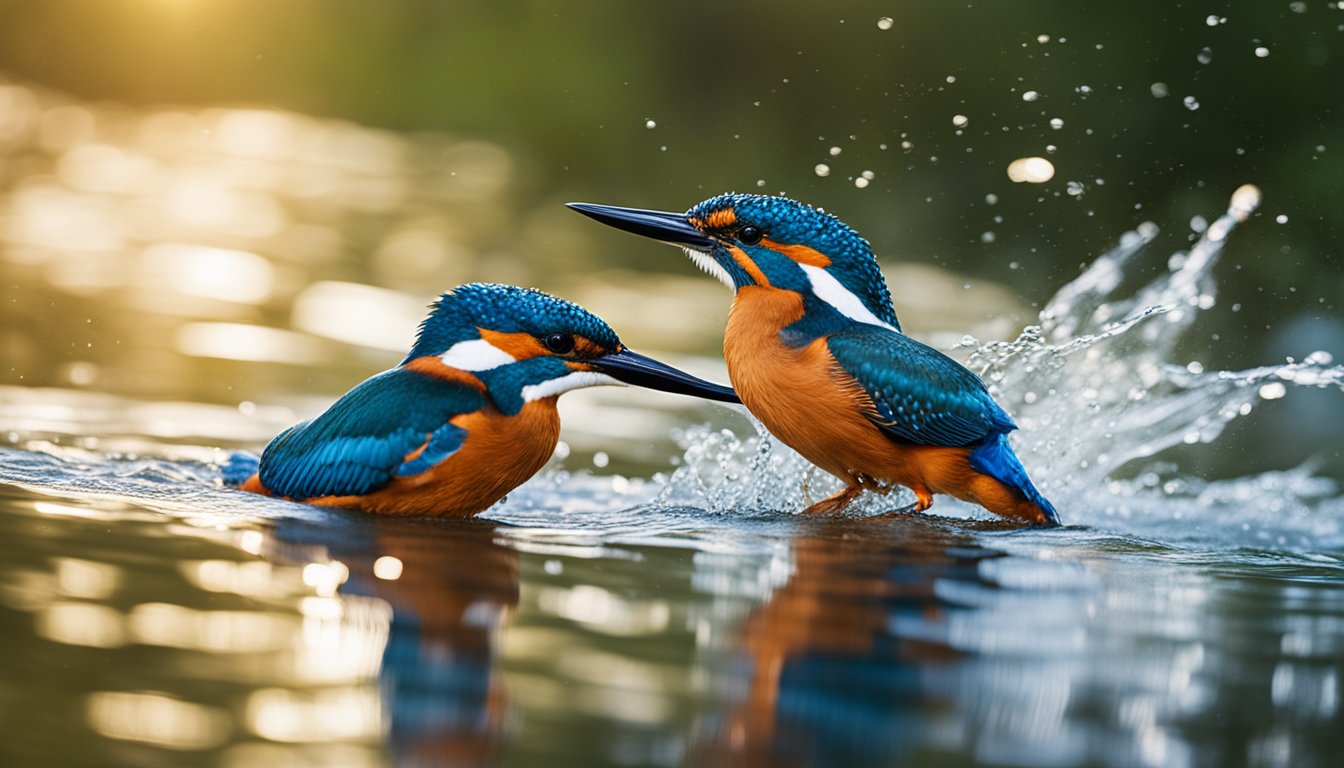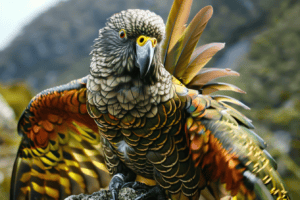Imagine standing by a calm river and spotting a flash of blue and orange zooming past.
That’s likely a kingfisher, one of the most skillful hunters of the rivers.
These birds are famous for their dazzling colors and impressive diving skills.
We see them perched quietly by the water before they suddenly leap into action, diving headfirst into the water to catch their prey.
It’s like they have superhero powers, isn’t it?

Kingfishers are a worldwide family, with different species making homes along rivers, lakes, and coasts.
Even though they’re all related, each species has its own unique traits. Did you know some kingfishers don’t even eat fish? It’s true!
These fascinating birds have diets that can include insects, frogs, and even small mammals.
Picture a little bird zooming out of the water with a wriggly snack, and you’ll have a pretty good idea of a kingfisher’s lunchtime.
Now, let’s talk about their hunting technique. When a kingfisher spots a fish from above, it dives down like a bullet.
They must calculate the depth and refraction of light in the water, which sounds like a tricky bit of math, right? But these birds are naturals at it.
They can change their eye’s focus from air to water in an instant, helping them to see clearly underwater and grab their catch.
We can learn a lot about precision and patience by watching these diving dynamos in action.
Exploring the Kingfisher’s Habitat

Let’s take a peek into where our dazzling diving friends, the kingfishers, feel right at home.
From tranquil freshwater rivers to the dynamic coastal shores, they’ve mastered the art of adapting to various watery worlds.
Freshwater Havens
In our journey to freshwater habitats, we find kingfishers thriving by streams, rivers, and lakes where clear, calm water gives them an excellent view of their prey.
Scan the overhanging branches, and you might spot them perched silently before they plunge headfirst into the water.
They prefer these serene settings because they can easily spy small fish and insects in the undisturbed water which makes up their diet.
Have you ever wondered why these birds favor such spots?
It’s because the slower-moving waters in these areas make it easier for them to fish, proving that kingfishers are not just beautiful; they’re smart hunters too!
Coastal and Marine Abodes
Now, let’s wade over to the salty seascape where some kingfisher species feel just as at ease.
Although less common than their freshwater counterparts, coastal kingfishers can be spied along the shores, in estuaries, and even mangrove swamps.
These locations are buffet bars for kingfishers, offering a scrumptious selection of seafood.
Have you ever seen a bird zip through the air, then swoop down to snag a crab for dinner? That’s our coastal kingfisher!
Their vibrant plumage is not only pretty but also practical, blending with the vivid colors of the coastal scenery to keep them hidden while they hunt.
Isn’t it fascinating how a bird can be equally at home in a quiet river as it is in the lively hustle and bustle of the ocean’s edge?
Anatomy of a Diver

When we watch kingfishers, we’re witnessing some of the most specialized hunters around!
They’ve got features that tailor them perfectly for life both above and under the water.
Let’s explore what makes these birds so good at diving.
Aerodynamic Bodies
Kingfishers have streamlined bodies. To us, they might look like darts with wings, and that’s pretty accurate!
When they dive, they need to be as sleek as possible to cut through the air and water with minimal resistance.
Their smooth feathers lie flat against their bodies, reducing drag.
Isn’t it clever how nature has shaped them like little torpedoes for the perfect plunge?
It’s easy for us to think of our own streamlined shapes when we go swimming.
Imagine how we use swim caps to keep our hair flat and wear snug-fitting swimsuits.
Like us, kingfishers also need to reduce any fluff that could slow them down.
Just imagine if we could fold our arms in as neatly as they tuck their wings while diving!
Precision Hunting Tools
Ever noticed how kingfishers always seem to catch something when they dive?
They’re not just lucky; they’re equipped with some serious precision hunting tools.
Their eyes have evolved to judge distances accurately in the air and under the water, where light bends differently.
By the way, it’s similar to when we put on goggles to see clearly underwater.
These birds aren’t fishing blindly.
They’ve got specially adapted eyes that help them adjust focus between two mediums, which is really important when you’re snagging a fast-moving fish.
Now, their beaks are also worth talking about. Long, sharp, and strong – they’re like built-in spears.
This allows them to grab and hold onto slippery fish with ease.
Wait, there’s more! Kingfishers also have a third eyelid, a nictitating membrane, which is like a pair of built-in swimming goggles.
This membrane blinks over their eyes as they dive, protecting them and offering clear vision even underwater.
So next time we pull on our goggles and imagine we’re diving down to the riverbed, let’s remember we’re imitating the incredible kingfisher’s underwater view!
The Kingfisher’s Diet and Hunting Techniques

When we watch kingfishers, we’re seeing expert fishermen at work.
These colorful birds have a taste for a watery feast, mainly made up of small fish.
But that’s not all they’ll munch on! They also snack on aquatic insects, tadpoles, and even small crustaceans.
It’s like the river is their own personal all-you-can-eat buffet!
Now, let’s imagine that we are kingfishers for a moment.
We would need some pretty clever techniques to catch our slippery meals—and that’s exactly what kingfishers have.
First off, they use their keen eyesight to spot potential snacks from a perch above the water.
Once they’ve locked onto a target with their laser-sharp vision, they dive headfirst into the water.
Splash! In they go, beak first, to snag their prey.
Their specially shaped beak helps a lot here. It’s like a fishing spear that’s perfect for grabbing and catching their underwater meals.
After a successful dive, they’ll fly back to their perch to enjoy their catch.
One fun fact: before eating a fish, they’ll often smack it against their perch to make sure it’s extra tender. Clever, right?
But it doesn’t end there. Have you ever wondered how they see so well underwater?
It turns out their eyes have a special cover—a nictitating membrane that is like a pair of built-in goggles, protecting their eyes and helping them see while they zoom through the water.
Kingfishers are truly the dynamos of the river with their dazzling dives and clever hunting skills.
And just think, each time we spot one, we’re witnessing a master hunter in action, right in our midst. Isn’t nature amazing?
Conservation and the Future of Kingfishers

Kingfishers are amazing birds, aren’t they? But did you know that they need our help?
Our actions can make a big difference in the lives of these flashy fliers.
To keep these birds dazzling future generations, we need to focus on conservation.
First off, let’s talk about habitat preservation. We love seeing kingfishers dive, right?
For that, they need clean rivers and plenty of fish.
We can help by keeping waterways free from pollution and making sure their homes aren’t destroyed.
Conservation efforts also include legal protections. In some places, kingfishers are lucky to be legally shielded.
This means that we can’t just go around disturbing their nests or cutting down trees they call home.
You might wonder, “How are kingfishers doing in the wild?” Well, some kingfisher species are doing okay, but others are not so lucky.
The Alcedinidae family, to which they belong, has species ranging from Least Concern to Endangered on the IUCN Red List.
For example, the glorious giant kingfisher is currently listed as Least Concern, which is great!
But not all kingfishers have the same luck.
Climate change is another puzzle piece. We see odd weather patterns and rising temperatures, which can confuse these little birds.
They might not find food if the seasons are all mixed up!
Here’s a cool fact: Kingfishers nest in burrows along river banks. It’s like a hideout for their eggs!
But, if we’re not careful, erosion could wash these precious homes away.
So, what can we do? We can support local conservation groups, be mindful of how we treat our waterways, and spread the word about these diving dynamos.
Together, we can help ensure that kingfishers light up our rivers with their brilliant blues and oranges for a long, long time.
Frequently Asked Questions
Let’s dive into some splashy curiosities about the magnificent kingfishers.
We’ll explore their diving techniques, various species, cultural significance, special adaptations, unique calls, and their role in nature’s web.
Why do kingfishers dive into rivers and how do they catch their food?
Kingfishers are expert hunters.
We see them plunge into rivers because that’s how they catch their meals—typically fish and small aquatic creatures.
Their eyes are like top-notch goggles, adjusting for the water’s refraction, guiding them to snatch prey with remarkable precision.
Can you tell me about different types of kingfisher species and where they live?
There’s a whole rainbow of kingfisher species—from the azure flash of the Common Kingfisher in Europe to the chocolate-brown Kookaburra of Australia.
These birds perch at home in forests, by rivers, and in mangroves, each species suiting its unique corner of the globe.
What is the significance of kingfishers in various cultures and myths?
Throughout history and across continents, kingfishers have fluttered through our stories and beliefs.
In many cultures, they’re symbols of peace and prosperity.
The sight of their glinting blue feathers has been a sign of good luck to sailors and fishers alike.
How do kingfishers use their special adaptations to thrive in their habitats?
Kingfishers are like the superheroes of birdland with their superpowers.
They have extra stiff feathers for speedy diving and an oversized, dagger-like beak perfect for fishing.
Their feet can grasp slippery prey, and they’ve developed a keen eye for spotting the tiniest of movements in water.
What sort of sounds do kingfishers make and what do these sounds mean?
Listen closely—kingfishers have a range of calls from high-pitched peeps to loud trills.
These sounds are their way of chatting with each other, defending their territory, and calling out to potential mates.
Each chirp and whistle has its purpose in their daily life.
What role do kingfishers play in the ecosystem, and how do they interact with their environment?
Kingfishers may be small, but they have a big job in keeping rivers healthy.
They help manage fish populations, and their abandoned burrows can become cozy homes for other creatures.
Our winged friends are crucial puzzle pieces in the intricate mosaic of the ecosystem.









